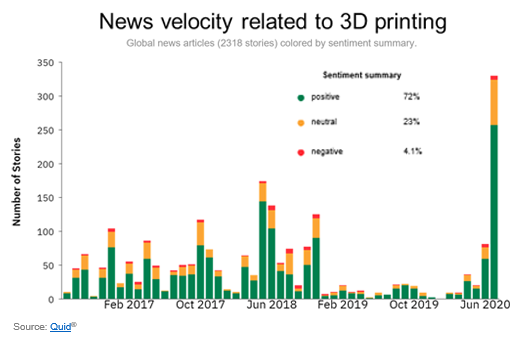Innovation in life science accelerated as researchers raced to find a vaccine for COVID-19, but therapeutic research is not the only area that has been experiencing an acceleration. Pandemic-induced economic shutdowns during the spring and summer of 2020 disrupted life sciences supply chains, and surging demand for personal protective equipment, ventilators and testing supplies pushed companies to develop alternative sourcing and manufacturing methods for these essential products. While many manufacturers outside of the medical device and supplies sector retooled to support sufficient supply, it also lead to a renewed focus on the potential for 3D printing in the life sciences industry.
Additive manufacturing, more commonly known as 3D printing, was created in the 1970s, but has taken off in the last decade as patents have expired and people have broader access to machines and materials. Parts for prosthetics, dental implants and hearing aids are some areas where 3D printing is already commonly used in the life sciences space, in large part because these products are not suited for large production runs, and require relatively basic printing material. Doctors have also used the technology to print 3D replicas of patients’ organs to practice on before surgery, so they have a better understanding of how to navigate unique anatomies. Uses within pharma and biotech have been slower to develop given the highly complex task of using biologic and pharmacological elements as a printing medium.
Adaptable and flexible manufacturing
The number of technologic advances and commercial applications are growing as 3D printing has made it easier to adapt and innovate in the face of production shortages and supply chain bottlenecks during the pandemic, especially around medical devices and products. Unlike traditional manufacturing processes, 3D printing does not require burdensome machinery changes in order to develop different types of products; rather, only the design file and printing material needs to change. And as we have seen with supply shortages during the COVID-19 pandemic, this allows companies and individual enthusiasts to easily pivot from one product or component to another.
The U.S. Army Research Laboratory, for instance, used 3D printers to make low-cost, emergency ventilators to respond to the COVID-19 crisis, the Department of Defense said in May. Companies and volunteer groups around the United States manufactured face masks and face shields using the technology.
The fact that 3D printing has allowed companies to solve urgent problems around medical supplies and equipment during the pandemic has also renewed momentum and excitement around other possible applications in the biotech, pharmaceutical and medical device industries. While scientists have in recent years been making advances toward 3D printing of biologics (e.g., bones, trachea replacements and lung tissue), many of these more difficult-to-achieve applications have been viewed as something of a novelty. But the pandemic underscored the fact that few things are too improbable to at least try.
This is especially true as the materials used for 3D printing become stronger, more flexible and more versatile. While plastics, metals and composites were once the main options, scientific capabilities have progressed to the point of being able to 3D print pharmaceuticals. In 2018, for instance, Alder Hey Children’s Hospital in Liverpool, England, "administer(ed) 3D printed tablets to children as part of a research trial,” business news site Fast Company reported. That was one of the first high-profile studies in this area since that of Aprecia Pharmaceuticals’ seizure medication Spritam, the first 3D-printed medication approved by the FDA.
Using this technology for pharmaceuticals also unlocks new potential in the space of personalized medicine, a field that continues to grow, especially given concerns about efficiency and the environmental impacts of the pharmaceutical industry. An Associated Press investigation from 2008 found that "U.S. hospitals and long-term care facilities annually flush millions of pounds of unused pharmaceuticals down the drain, pumping contaminants into America’s drinking water." The way some cancer drugs are administered has “led to an estimated $3 billion worth of unused cancer drugs being thrown away each year,” according to a Forbes web post from April, and “on-demand 3D printing of supplements and drugs could help cut down on financial and ecological waste.” It may seem like science fiction, but innovations are bringing us closer to this reality.
Not just a novelty
There has been an increase in recent months in the amount of public conversation about 3D printing for medical or clinical uses, according to an analysis of news stories from the first two quarters of 2020 from data analytics company Quid. The data shows a dramatic second-quarter spike in the number of news stories mentioning 3D printing or additive manufacturing.


